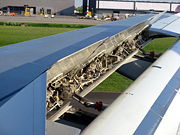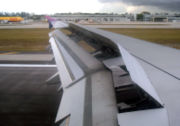.gif)
Spoiler (aeronautics)
Encyclopedia


Aeronautics
Aeronautics is the science involved with the study, design, and manufacturing of airflight-capable machines, or the techniques of operating aircraft and rocketry within the atmosphere...
, a spoiler (sometimes called a lift dumper) is a device intended to reduce lift
Lift (force)
A fluid flowing past the surface of a body exerts a surface force on it. Lift is the component of this force that is perpendicular to the oncoming flow direction. It contrasts with the drag force, which is the component of the surface force parallel to the flow direction...
in an aircraft. Spoilers are plates on the top surface of a wing which can be extended upward into the airflow and spoil it. By doing so, the spoiler creates a carefully controlled stall
Stall (flight)
In fluid dynamics, a stall is a reduction in the lift coefficient generated by a foil as angle of attack increases. This occurs when the critical angle of attack of the foil is exceeded...
over the portion of the wing behind it, greatly reducing the lift of that wing section. Spoilers differ from airbrakes
Air brake (aircraft)
In aeronautics, air brakes or speedbrakes are a type of flight control surface used on an aircraft to increase drag or increase the angle of approach during landing....
in that airbrakes are designed to increase drag making little change to lift, while spoilers greatly reduce lift making only a moderate increase in drag.
Spoilers are used by some older gliders
Glider (sailplane)
A glider or sailplane is a type of glider aircraft used in the sport of gliding. Some gliders, known as motor gliders are used for gliding and soaring as well, but have engines which can, in some cases, be used for take-off or for extending a flight...
to control their rate of descent and thus achieve a controlled landing at a desired spot. An increased rate of descent could also be achieved by lowering the nose of an aircraft, but this would result in an excessive landing speed. However spoilers enable the approach to be made at a safe speed for landing.
Airliner
Airliner
An airliner is a large fixed-wing aircraft for transporting passengers and cargo. Such aircraft are operated by airlines. Although the definition of an airliner can vary from country to country, an airliner is typically defined as an aircraft intended for carrying multiple passengers in commercial...
s too are usually fitted with spoilers. Spoilers are sometimes used when descending from cruise altitudes to assist the aircraft in descending to lower altitudes without picking up speed. Their use is often limited, however, as turbulent airflow which develops behind them causes noticeable noise and vibration, which may cause discomfort to extra-sensitive passengers. The spoilers may also be differentially operated to provide roll control. On landing
Landing
thumb|A [[Mute Swan]] alighting. Note the ruffled feathers on top of the wings indicate that the swan is flying at the [[Stall |stall]]ing speed...
, however, the spoilers are nearly always used at full effect to assist in slowing the aircraft. The increase in form drag created by the spoilers directly assists the braking effect. However, the real gain comes as the spoilers cause a dramatic loss of lift and hence the weight of the aircraft is transferred from the wings to the undercarriage, allowing the wheels to be mechanically braked with much less chance of skidding. Reverse thrust is also often further used to help slow the aircraft on landing.
In air-cooled piston engine aircraft, spoilers may be needed to avoid shock cooling
Shock cooling (engines)
Shock cooling refers to the theory that damage to engines may occur because of an excessively rapid decrease in temperature....
the engines. In a descent without spoilers, air speed is increased and the engine will be at low power, producing less heat than normal. The engine may cool too rapidly, resulting in stuck valves, cracked cylinders or other problems. Spoilers alleviate the situation by allowing the aircraft to descend at a desired rate while letting the engine run at a power setting that keeps it from cooling too quickly. (This is particularly true in turbocharged piston engines, which generate higher temperatures than normally aspirated engines.)
Spoilers as control surfaces
Some aircraft use spoilers in combination with or in lieu of aileronAileron
Ailerons are hinged flight control surfaces attached to the trailing edge of the wing of a fixed-wing aircraft. The ailerons are used to control the aircraft in roll, which results in a change in heading due to the tilting of the lift vector...
s for roll control, primarily to reduce adverse yaw when rudder input is limited by higher speeds. For such spoilers the term spoileron
Spoileron
In aeronautics spoilerons are flight control surfaces, specifically spoilers that can be used asymmetrically to achieve the effect of ailerons, i.e. to roll an aircraft by reducing the lift of one wing but unlike ailerons not increasing the lift of the other wing...
has been coined. In the case of a spoileron, in order for it to be used as a control surface, it is raised on one wing, thus decreasing lift and increasing drag, causing roll and yaw.
Spoilers, general description
Spoilers increase drag and reduce lift on the wing. If raised on only one wing, they aid roll control, causing that wing to drop. If the spoilers raise symmetrically in flight, the aircraft can either be slowed in level flight or can descend rapidly without an increase in airspeed. When the spoilers rise on the ground at high speeds, they reduce the wing's lift, which puts more of the aircraft's weight on the wheels.The flight spoilers are available both in flight and on the ground. However, the ground spoilers can only be raised when the weight of the aircraft is on the landing gear, usually activated by a sensor. When the spoilers deploy on the ground, they decrease lift and make the brakes more effective. In flight, a ground-sensing switch on the landing gear prevents deployment of the ground spoilers.
Incidents and accidents
- Air Canada Flight 621Air Canada Flight 621The deadliest accident at Toronto International Airport, now called Pearson International Airport, took place on July 5, 1970, when Air Canada Flight 621, a Douglas DC-8 registered CF-TIW, was flying on a Montreal–Toronto–Los Angeles route....
– Premature deployment of the spoilers at low altitude contributed to this crash in TorontoTorontoToronto is the provincial capital of Ontario and the largest city in Canada. It is located in Southern Ontario on the northwestern shore of Lake Ontario. A relatively modern city, Toronto's history dates back to the late-18th century, when its land was first purchased by the British monarchy from...
on 5 July 1970.
- United Airlines Flight 553United Airlines Flight 553United Airlines Flight 553 was a Boeing 737-222 that crashed on approach to Chicago Midway International Airport at 2:28 p.m. CST, on December 8, 1972. After the crew was told to go around and abort their first landing attempt on runway 31L at Midway Airport, the aircraft struck trees and then...
– Forgetting to deactivate the spoilers contributed to this crash at Chicago Midway International Airport on 8 December 1972.
- American Airlines Flight 965American Airlines Flight 965American Airlines Flight 965, a Boeing 757 registered , was a scheduled flight from Miami International Airport in Miami, Florida to Alfonso Bonilla Aragón International Airport in Cali, Colombia, which crashed into a mountain in Buga, Colombia on December 20, 1995, killing 151 passengers and 8...
– Forgetting to deactivate the spoilers while climbing to avoid a mountain contributed to this crash on 20 December 1995.
- American Airlines Flight 1420American Airlines Flight 1420American Airlines Flight 1420 was a flight from Dallas-Fort Worth International Airport to Little Rock National Airport in USA. On June 1, 1999, a McDonnell Douglas MD-82 overran the runway upon landing in Little Rock and crashed...
– Forgetting to deploy the spoilers contributed to this crash at Little Rock National AirportLittle Rock National AirportLittle Rock National Airport , officially Little Rock National Airport/Adams Field, is located 2 miles east of the central business district of Little Rock, a city in Pulaski County, Arkansas, United States. It is Arkansas' largest commercial service airport, serving more than 2.1 million...
on 1 June 1999.
- TAM Brazilian Airlines Flight 3054 – This Airbus 320Airbus A320 familyThe Airbus A320 family is a family of short- to medium-range, narrow-body, commercial passenger jet airliners manufactured by Airbus Industrie.Airbus was originally a consortium of European aerospace companies, and is now fully owned by EADS. Airbus's name has been Airbus SAS since 2001...
's pilots were aware of their deactivated starboard engine #2 thrust reverser, and so apparently did not attempt to use it to brake when attempting to land at São Paulo's Congonhas Airport on 17 July 2007. The plane's spoilers may have been their only method of braking at speed. The plane slid off the runway, over a major highway, and ploughed into a warehouse, killing all 186 on board as well as several on the ground. It was BrazilBrazilBrazil , officially the Federative Republic of Brazil , is the largest country in South America. It is the world's fifth largest country, both by geographical area and by population with over 192 million people...
's worst aviation disaster.

